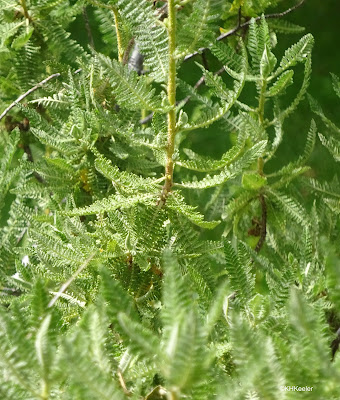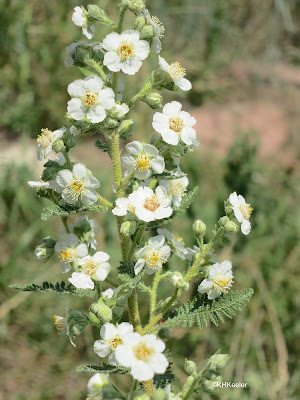The plant I call fernbush is an American shrub native to the U.S. west, from eastern Oregon and Idaho south to California and New Mexico. It grows to be about 10 feet tall, spreading to 10' wide. It has leaves with lots of divisions, hence the name fernbush, with a rich spicy scent. The flowers rise in spikes of white flowers with yellow centers. The USDA plants data base calls it desert sweet. An older plant book called it tansybush, because the leaves look like, and smell a little like, the garden plant tansy (Tanacetum vulgare).
 |
| fernbush Chamaebataria millefolium |
Fernbush's scientific name is Chamaebatiaria (in the rose family, Rosaceae). There is an older genus called Chamaebatia, comprised of two species of low shrubs, also in the rose family, which Chamaebataria resembles, consequently the scientific name is intended to say "like Chamaebatia." I find this ironic because fernbush has a much larger range. The two species of Chamaebatia are found only in California and northern Mexico while Chamaebataria is found over most of the far western U.S. and into Mexico. The similarities are strong. Both have compound leaves of many leaflets with a distinctive aroma, and white, open rose-like flowers. DNA studies do not find them to be close relatives within the roses, however. Apparently the botanist that named Chamaebataria already knew Chamaebatia.
There is only one species in the genus Chamaebataria, Chamaebataria millefolium, fernbush, and its native range is only six western states and a bit of Mexico, making it a regional endemic. The species epithet millefolium means "thousand-leaves" referring to the fern-like leaves and also to the leaves of yarrow, Achillea millefolium.
In its native range, fernbush grows on tough rocky soils, from cracks in the rocks, and colonizes lava flows. It is a resilient, drought-tolerant shrub.
 |
| leaves of fernbush Chamaebataria millefolium |
The flowers of fernbush are open, five-petaled white flowers with yellow stigmas and stamens in the middle, very much the basic shape of wild roses and other members of the rose family. They make a dramatic showing and attract numerous large and small bees, butterflies, little wasps, and flies.
 |
| flowers of fernbush, Chamaebataria millefolium |
Extracts of "Chamae Rose" are sold as natural remedies, for detoxifying, skin rejuvenation, and purifying the blood. There does not appear to be any scientific study of the medicinal claims. In 2003, Tucker and colleagues tested the leaf chemistry and found no compounds with medical properties to differentiate fernbush chemistry from the chemistry of leaves generally, writing, "In conclusion, no essential oil constituent supports the medicinal claims for "Chamae Rose."(p. 574). As far as I can tell, that remains the scientific last word.
 |
| fernbush, Chamaebataria millefolium |
Moerman, D. E. 1998.Native American Ethnobotany. BRIT Press, Fort Worth, Texas.
Mozingo, H. N. 1987. Shrubs of the Great Basin. University of Nevada Press. Reno, Nevada.
Nold, R. 2008. High and Dry. Gardening with Cold-Hardy Dryland Plants. Timber Press. Portland, Oregon.
Tucker, A. O. , M. J. MacIarello, J. Hendrickson and J. Davis. 2003. The essential oils of Chamaebatiaria millefolium, Chamaebatia australis, and Chamaebatia foliolosa (Rosaceae) and comments on "Chamaebatiaria multiflorium" and "Chamaebatiaria nelleae" as medicinal plants. Economic Botany 57 (4): 570-575. link (Accessed 1/7/24)
No comments:
Post a Comment